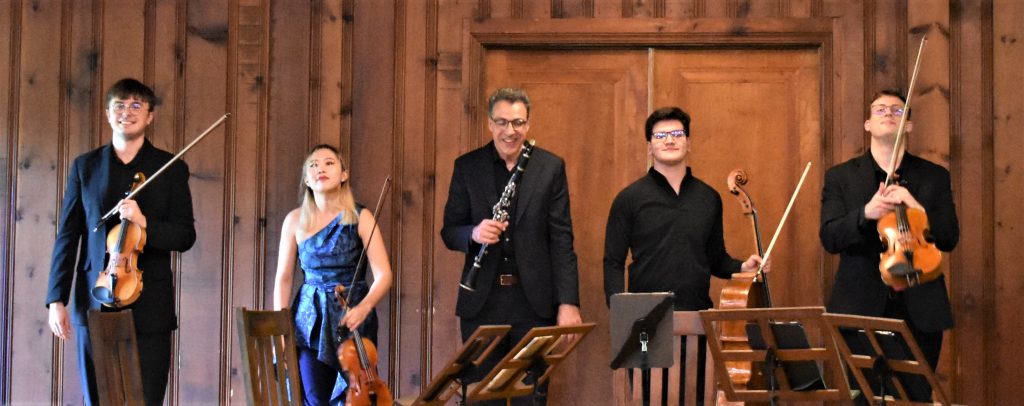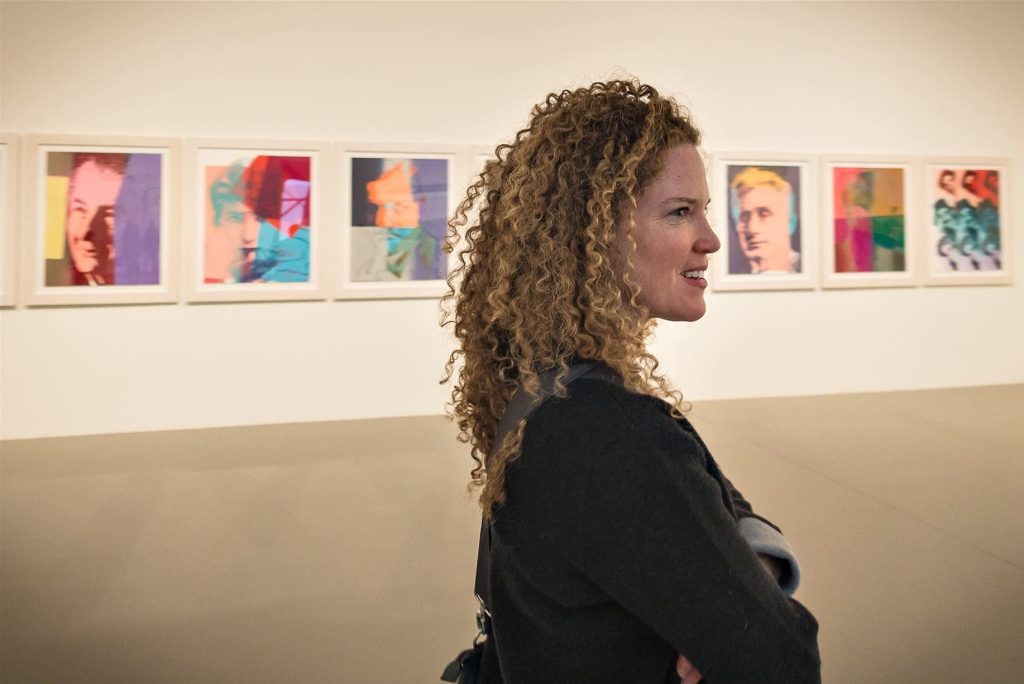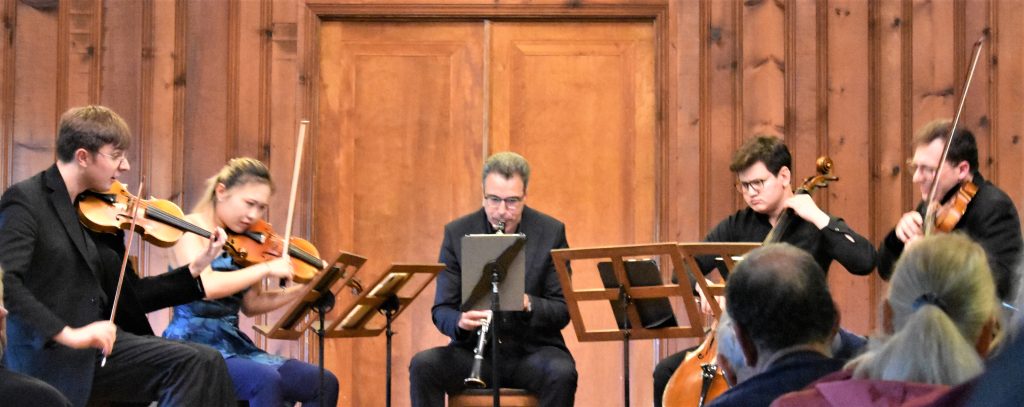
by Kevin T McEneaney
With cumulus clouds scudding through blue skies at Music Mountain, the Baldouret Quartet created their own musical sunlight at Gordon Hall with a diversified menu. The quartet is named after the noted chef Antoine Baldouret at the Taos Music School in New Mexico with whom they bonded over music and food.
They opened with String Quartet in D Minor, K. 421 (1783) by Wolfgang Amadeus Mozart (1756-1791). This work is rarely performed, although it’s popular at Music Mountain, since this was the thirteenth performance there; often nicknamed the “second Haydn Quartet,” written when Mozart briefly studied under Haydn who approved the composition. The opening Allegro is an exciting shocker as first violinist Justin Defilipps on violin delivered dramatic high screeches amid fevered pace. The downward plunge of an octave was most unsettling. So what is this hysteria all about? The first movement sounds more like a Scherzo than an Allegro!
This work was written during the birth of Wolfgang and Contsanze’s first child. Mozart wrote the composition in their bedroom in the presence of his wife and midwife. I have twelve books on Mozart, but only Jan Swafford’s biography of Mozart speaks of the setting. The first movement is either the excited anticipation of the newborn baby or a dramatization of the childbirth itself, done with a birthing chair, which was a difficult, bloody process, yet successful, even though it was not completely clear for the next two days if Constanze would recover. Raimond Leopold Mozart was named after Mozart’s landlord.
Constanze once wrote to a friend that the second and third movements were written in the bedroom during the birthing and her two days of recovery. The second movement Andante, slightly Haydnesque, was so warm, and loving that I wanted to hear it again. Russell Houston’s cello was so tender that I fell in love with the cello and Benjamin Zannoni’s viola floated such light-hearted serenity that I was captivated and prepared for any caprice.
The following Minuet offered a puckish celebration with a slow, meditative descent, perhaps a forward-looking anticipation of Raimond’s first steps. The concluding Allegretto was a delightful summation of all is well, whereby the writing may have acted as a tonic that cured the composer of a long-standing cold. (Wolfgang had stopped drinking during the birthing and recovery of Constanze.) On second violin, Angela Bae carefully assisted that calm transition back to reality at the conclusion with a quick, joyous pace created through the addition of an extra note that repeated a triplet motif from the first movement.

The Eight Lost Songs of Orlando Underground for Clarinet Quintet (2018) by Anna Weesner followed with Music Mountain Director Oskar Espina Ruiz on clarinet. This was its first performance at Music Mountain. Anna Weesner teaches music at the University of Pennsylvania. Her work has been performed by numerous contemporary musicians; her compositions have won many awards.

The composition is about love and loss in eight movements. The clarinet is the instrument searching for real and lasting love. Ruiz was most eloquent in the warm, sensitive lower notes of lament that communicated from ear to heart in the predicament of loss. The clarinet also functions as the conscience of the narrator’s perspective.

The structure of the work offers symmetry with its obsession with fives: five instruments, five movements that become ten as if the second five were an inverted depiction of someone looking into a mirror and seeing a slightly distorted image of self. Each of the eight movements featured a different musical style: pop, blues, modern classical, folk song, pop dance music, classical romantic lament, and post-modern classical symphonic. This was a work that, at first hearing, offered a great deal to digest. Retrospectively, it seemed like a slide show that went by one’s eyes and ears much too fast!
After intermission String Quartet in F Major, Op. 59 # 1 (1806) by Ludwig van Beethoven was performed. This was the first of three “symphonic quartets” commissioned by Count Razumovsky, the Russian ambassador to Vienna. Beethoven began working on the first of the three compositions on the day after his brother Carl’s marriage to a woman Beethoven despised (she was five months pregnant, nineteen years old from the middle class). Each of the three quartets was to employ a Russian melody. In the previous year, Beethoven had acquired a large three-volume anthology of Russian folk tunes and was eager to work with it; he was entering a rapturously productive period putting his brain on the cusp of insanity. (Many musicians are more rational in their work than in life.)

The first of these three quartets is the longest; all three are in sonata form. The first quartet promises to be a sequential continuation from the Eroica, beginning with some notes from its finale. For this performance, Angela Bae assumed the role of first violinist. The opening cello melody is entrancingly ambiguous and finally settles into F Major, then initiates a long captivating fugue as if Beethoven was proving that he could outdo Bach in that genre. The interweaving instruments of the four players were astonishing in the opening Allegro. The delay in recapitulation adumbrates what will happen in the climatic finale.
This second movement, Scherzo, is lively, unconventional, and considered Beethoven’s greatest scherzo, displaying an integration of extreme themes, which was handled with amazing ease here with the two violins offering contrasting development with cunning intricacy.
The slow third movement Adagio presents a mournful aspect; it is the longest and most complex slow movement that Beethoven had written since his funeral march in his Eroica. Here the musicians on stage were tightly together as they invoked palpable melancholy.
The fourth movement offers the Russian melody in double time. The folk tune is a soldier’s lament on his return from war. (Stravinsky may have gotten his idea for A Soldier’s Tale from this movement.) The presentation of this melody has definite intervallic relationships to the first and third movements. There were more crescendos than I could count and this delaying (as well as integrating) motif became an experience that created rapture at the conclusion where all four players seemed to exceed collectively their mutual abilities. This was contagious joy, but what was the direction of that joy? I imagine peace and love!

The audience rose with thunderous applause, demanding three bows. They performed the last movement of Franz Joseph Haydn’s quartet, The Birds, No. 33, for an encore.
Next Sunday’s Classical Chamber Series at 3 pm will feature The Euclid Quartet with a program of AUDER, BOLCOM, BRITTEN, and SCHUBERT String Quartet in D Minor, D. 810, “Death and the Maiden.”
Here is the link to Music Mountain: https://musicmountain.org/chamber_concerts